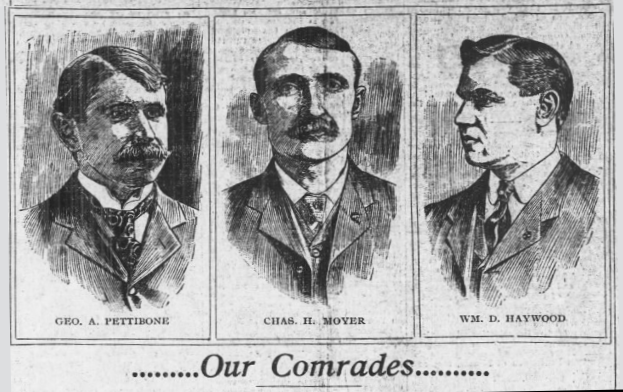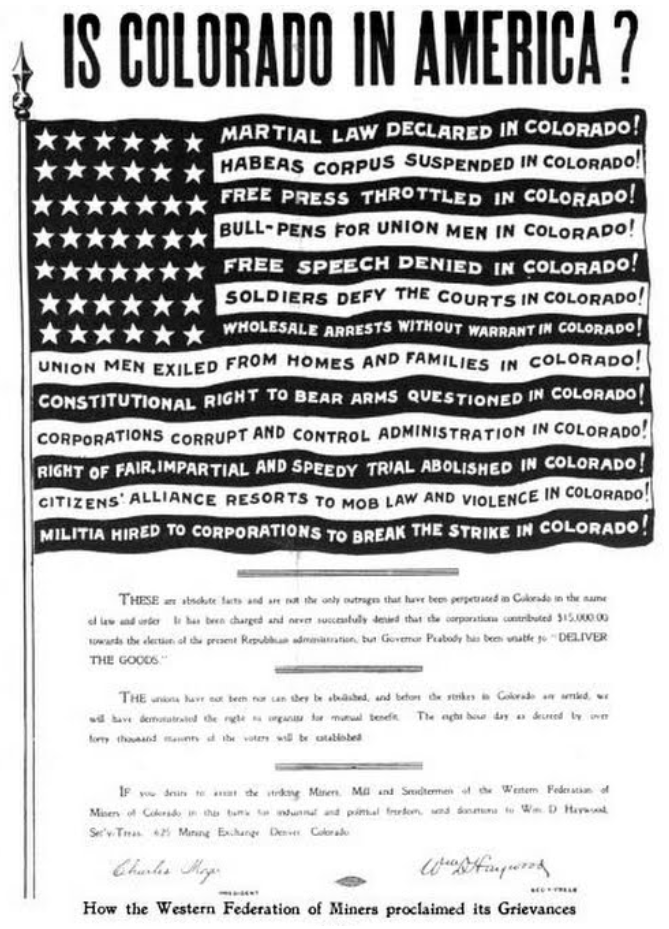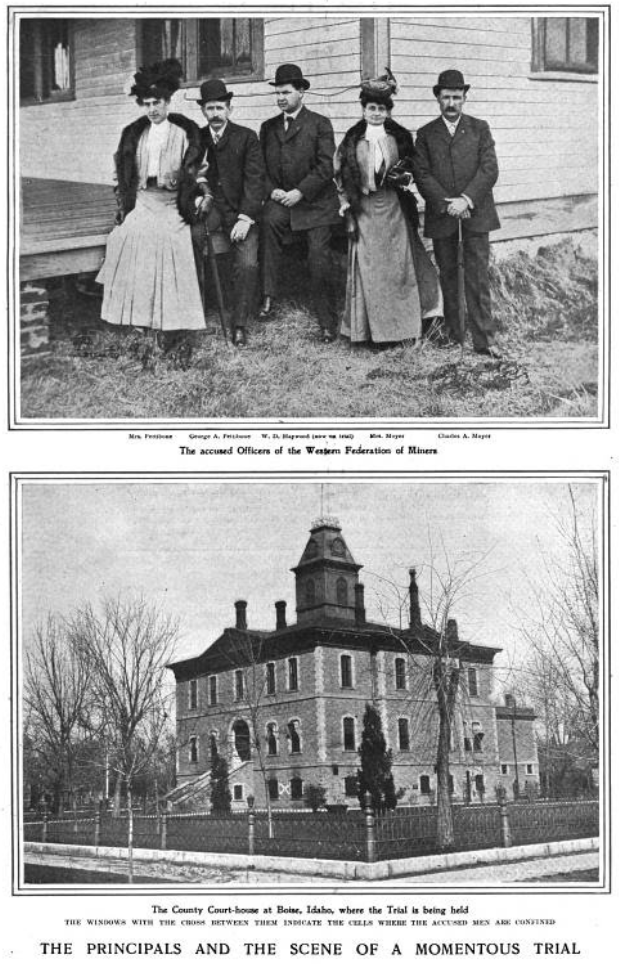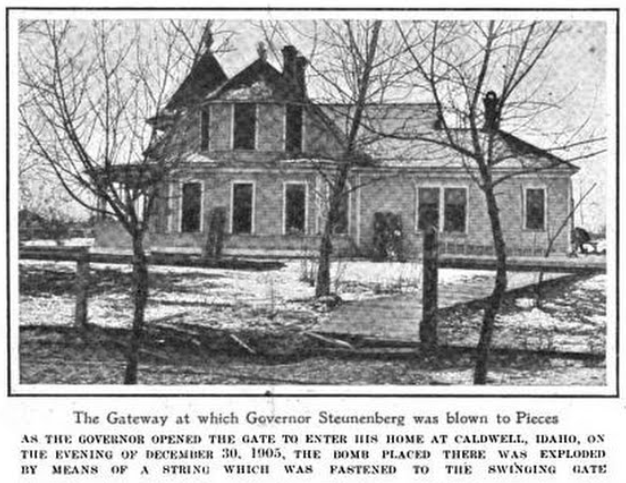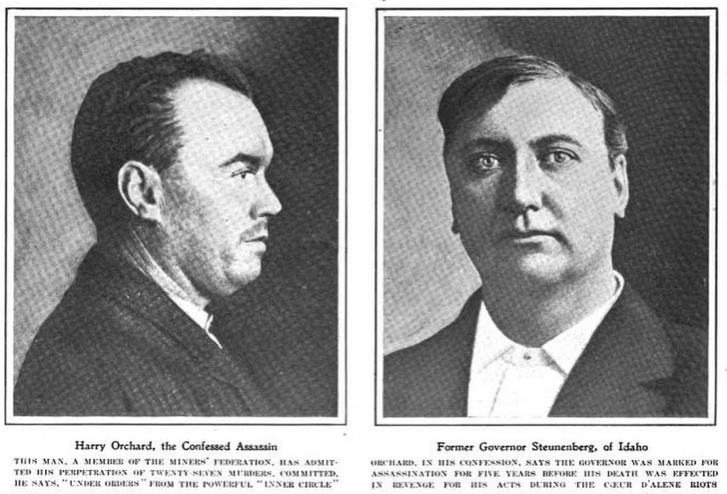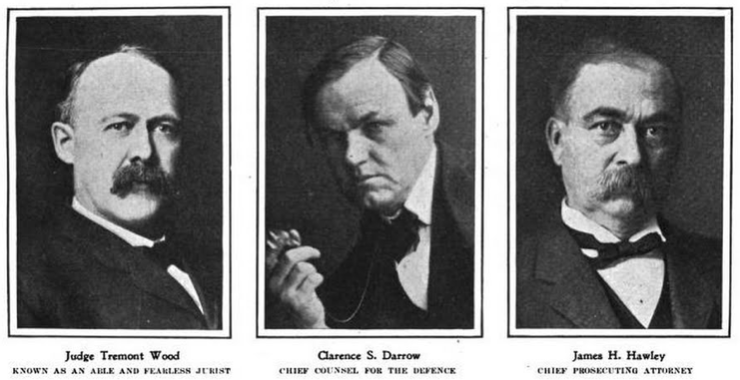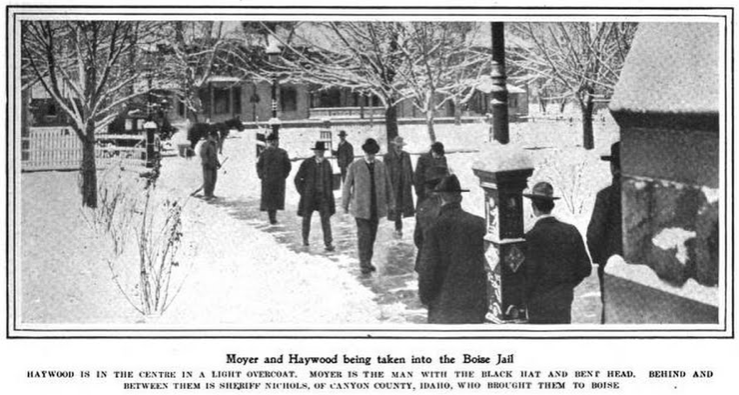There are no limits to which
powers of privilege will not go
to keep the workers in slavery.
-Mother Jones
Hellraisers Journal, Thursday May 30, 1907
Boise, Idaho – William D. Haywood on Trial for Murder
From Harper’s Weekly of May 25, 1907:
THE MURDER CHARGE AT A
LABOR UNION’S DOOR
BY THE CONFESSION OF ONE OF ITS MEMBERS, THE WESTERN
FEDERATION OF MINERS IS CHARGED WITH HAVING INSTIGATED
TWENTY-SEVEN MURDERS, INCLUDING THE ASSASSINATION, IN 1905,
OF FORMER GOVERNOR STEUNENBERG, OF IDAHO. FOR COMPLICITY
IN THIS CRIME, W. D. HAYWOOD, OF THE FEDERATION’S
“INNER CIRCLE,” IS ON TRIAL FOR HIS LIFE
AN attempt to learn the truth about the most serious charge that ever has been laid at the doors of organized labor is now being made at Boise City, Idaho. William D. Haywood, secretary-treasurer of the Western Federation of Miners, is on trial in the District Court, charged with the murder of Frank Steunenberg, former Governor of Idaho. Two other officers of the Federation are jointly accused, but they will be tried separately. One remarkable fact which provokes arguments for and against the organization is that the evidence upon which Haywood and his associates have been indicted is based upon the confession of a member of the Federation who is reported since to have lost his reason.
The three men charged with conspiracy and murder are Haywood, Charles H. Moyer, President of the Western Federation of Miners, and G. A. Pettibone, formerly a member of the supreme governing body of the organization. These three are men of unusual intelligence and high executive ability.
The principal accuser of the defendants is Harry Orchard, who has declared in a story of great detail that he committed this and twenty-six other murders under the direction of these men. Stephen Adams made a confession largely corroborating Orchard, but he has since repudiated it, saying that he told the story because he was afraid of being made a scapegoat. Another member of the Federation supposed to have been one of the so called “Inner Circle” which directed the murderous plans, is L. J. Simpkins, who has been indicted, but is a fugitive.
According to Orchard’s confession it was he who assassinated Steunenberg, besides committing twenty-six other murders by shooting, dynamiting, train-wrecking, etc., under direction of the defendants, but at times when Haywood, Moyer, and Pettibone were actually in another State. The prosecution has presented a list of fifty-one witnesses by whom it expects to prove the truth of Orchard’s assertions.
Haywood and his associates declare that they welcome this trial because it will give them the opportunity to prove their innocence beyond doubt. The issue will be contested to the utmost limits of the law. The case against Haywood is admittedly the strongest that the prosecution has. Should this fail, it is likely that the proceedings against Moyer and Pettibone will be dropped. The State is represented by an array of eminent counsel. So is the defendant Haywood, and a great defence fund has been raised among labor organizations through out the United States. It is known to run well up into the hundreds of thousands of dollars, and some estimates place it as high as $1,000,000.
The facts directly connected with the arrest of the three chiefs of the Federation are these: Frank Steunenberg, former Governor of Idaho, had been followed and watched for months by Harry Orchard, who sought to assassinate him. Twice Orchard tried to shoot his victim, but failed. One of these times was arranged, with diabolical ingenuity, for Christmas Eve, but as he was walking home that night with his son and his brother the plan miscarried. Then Orchard planted a bomb under the back gate of his victim’s home. At six o’clock on the evening of December 30, 1905, Steunenberg started for home. Orchard, who had been on watch for hours, stealthily hurried ahead of him by another route. Waiting on the corner, the assassin saw the object of his vengeance approach. Even in the gloomy dusk there could be no mistaking that gigantic figure.
Orchard hurried along. At the Steunenberg gate he dropped an open newspaper. Stooping to pick it up, he quickly fastened to the gate the wire which led underground to a bottle of sulphuric acid inside the bomb. Orchard walked briskly away to a safe distance and turned to watch. Steunenberg pushed open the gate, the tug of the wire broke the bottle of sulphuric acid and set off the bomb. The explosion killed Steunenberg, tore him to pieces.
James McParland, an old detective who first gained fame by patient and fearless investigation which led to the hanging of eleven leaders of the Molly Maguires, a secret organization that murdered by wholesale and spread terror through the coal regions of Pennsylvania, was called out to Idaho and put to work on the case. He followed the same plan he had used in the Molly Maguire cases thirty years ago—went to work as a miner and learned of the Inner Circle in the Western Federation of Miners. When the time came to strike he had Orchard arrested, kept in solitary confinement with “plenty of food and good cigars, but with nothing to read and no one to talk with him.
After a few days of this treatment Orchard began to show signs of breaking down. McParland worked upon his emotions by talking about his old mother at home in Pennsylvania, his early religious training, the certainty of judgment day and future punishment, and urged him to repent of his sins. Orchard broke down and confessed. McParland spent three days writing down his utterances. To read them requires seven hours. The confession is one of the most amazing documents in the history of crime. Neither the chronicles of the Medici and Borgias nor the imaginings of Poe and Stevenson can furnish any parallel to this tale of slaughters planned with devilish ingenuity and wrought with cynical brutality.
Such a confession as this will be useless as evidence unless corroborated by the testimony of unimpeached witnesses carrying to the minds of the jury conviction beyond a reasonable doubt. This corroboration the State promises it will furnish. The defence declares that corroboration is impossible, that Orchard is not only a trapped and self-accused murderer, but a person of unsound mind who has tried to purchase his wretched life by dragging in accusations against innocent officials of a hated organization.
But before going into the details of the confession it is necessary to go back to the history of the Coeur d’Alene mining troubles in the late nineties. The miners went on strike, and non-union miners were brought in to take their places. A trainload of men, said to be strikers, dynamited the $300,000 mill of the Bunker Hill and Sullivan mine at Wardner. Rioting, arson, and bludgeoning followed. The militia of Idaho were off to the Spanish war. With improvised militia and regular troops of the United States army, chiefly negroes, Steunenberg, then Governor of Idaho, arrested the union labor leaders and eight hundred of their followers and confined them within barbed-wire stockades in the famous “bull pen” of the Coeur d’Alene. There were many charges that the troops outrageously abused the prisoners. Steunenberg, a plain, decent citizen, farmer and banker, who went into office as a friend of labor, retired at the end of his second term as Governor an object of the execration of thousands of miners.
There were other hated men. After the Coeur d’Alene trouble came the famous Cripple Creek and Telluride strikes in Colorado, with accompaniments of assault, arson, dynamiting, and murder. Hundreds of the striking miners were deported by the troops. The struggle cost many lives and millions of dollars, and the strikers were defeated. Governor James H. Peabody, of Colorado; D. H. Moffat, a millionaire miner; and Justices Gabbert and Goddard, of the Supreme Court, were sentenced to death, according to Orchard’s story. Many men of less note were also to be destroyed.
Orchard admitted that he killed the nineteen nonunion miners who were blown to death as they stood on the railroad platform at Independence, Colorado. He swore that the plot was perfected in Haywood’s rooms in Denver. To establish an alibi. Orchard left Independence the day be fore the killing in the company of a man named Neville.
Orchard made a pretext to steal back to Independence, and there he pulled the string that set off one hundred pounds of dynamite under the platform on which the victims were standing. Next day Neville accused Orchard of the crime, and he admitted it. Neville, fearing arrest, fled to Nevada. Orchard feared he might tell. A man named Sapp was hired to poison Neville for $1600. Neville died.
Superintendent McCormick and Foreman Buck, of the Vindicator Mine, were blown to pieces one night by a bomb on the sixth level. Orchard swore that he put the bomb there under orders, but by error missed putting it on the seventh level, where it would have killed fifteen or twenty non-union miners.
As an instance of the anger aroused among the Western Federation of Miners by Governor Steunenberg’s action in dealing with the Coeur d’Alene troubles, the inflammatory poster reproduced [above] was circulated throughout the Western, mining region. Below the flag appeared these statements:
These are absolute facts and are not the only outrages that have been perpetrated in Colorado in the name of law and order. It has been charged and never successfully denied that the corporations contributed $15,000 towards the election of the present Republican administration, but Governor Peabody has been unable to DELIVER THE GOODS.
The unions have not been nor can they be abolished, and before the strikes in Colorado are settled, we will have demonstrated the right for mutual benefit. The eight-hour day as decreed by over forty thousand majority of the voters will be established.
If you desire to assist the striking Miners, Mill, and Smeltermen of the Western Federation of Miners of Colorado in this battle for industrial and political freedom, send donations to Wm. D. Hay wood, Secretary-Treasurer, 625 Mining Exchange, Denver. Colorado.
(Signed) Charles Moyer, President
(Signed) Wm. D. Haywood, Sec’y-Treas.
Merritt Walley was murdered in Denver with a bomb intended for Chief-Justice Gabbert. Arthur W. Collins, manager of the Smuggler-Union Mine at Telluride, was shot in the back, through the window of his home. J. W. Barney, a shift boss; John Mahoney, a non-union miner at Telluride; and Martin Gleason, a mine manager at Cripple Creek, who dared to advocate non-union labor—all were assassinated. A mining engineer named Bradley was murdered while in San Francisco on his honeymoon. Orchard swears that this was all his work, under orders from Moyer and Haywood.
Three attempts were made to kill Governor Peabody, of Colorado. Once, Orchard says, he and Simpkins planted a bomb for him in the street. It was to be touched off by a wire as Mr. Peabody passed the spot. A coal-wagon backed on the wire just as Peabody came along and put it out of working order. Another time it was planned to shoot him in front of his home at night as he alighted from his carriage. As it happened, only the women of his family were in the carriage, and the Governor escaped. Another time it was planned to decoy him home from a meeting in an automobile and kill him on the way. A man mysteriously warned him one afternoon of this danger, and again he was saved.
Another assassination that failed, as has been indicated, was that planned for Chief-Justice Gabbert. He with Justice Goddard had offended the striking miners by decisions and strictures on the order. He usually crossed a vacant lot on his way to the court chambers. A bomb was planted and a satchel purse, with wires attached, was put on the ground. It was supposed that the chief justice would pick up the satchel and set off the bomb. Judge Gabbert saw a friend near by that morning and joined him instead of crossing the vacant lot. It was the first time in months that he had deviated from his custom. Another man came along, picked up the satchel, and was blown to bits. The explosives in the bomb were so arranged that when the satchel was picked up sulphuric acid would be spilled on them and set them off. Orchard says he set the bomb by orders.
Justice Goddard escaped assassination through the slip of a pin. No one knew anything about it until Orchard confessed. He said a screw-eye would be found in Justice Goddard’s gate. Near by, he said, was a bomb. A wire was attached from the screw-eye to a bottle containing sulphuric acid. When the gate was opened the string was to pull the cork of the bottle and spill it over 100 giant caps. The bottle was planted five days before the time came to arrange the wire. The acid had eaten the pin, so that when Justice Goddard passed through his gate the pin and not the cork came out.
When Justice Goddard was informed of Orchard’s confession he examined his gate and found the screw-eye. Then Adjutant-General Bulkley Wells, of Colorado, scratched the earth until he found the wire and pin attached to the cork. Then he scraped the ground with great caution, and found the bomb exactly where Orchard said it was, and exactly of the description Orchard had given.
The plan to kill D. H. Moffat was to drop a bomb from a window as he walked along the street. The plan was foiled by Mr. Moffat’s sudden departure for Europe.
The most notable attempt at train-wrecking was on the night of November 14, 1903, when a train carrying Governor Peabody and about 200 men and women to a ball in Victor, Colorado, from Cripple Creek, nearly plunged over the curve on a 300-foot embankment. A rail had be«n loosened. A friend of the engineer did not want his life lost, and warning was given to him to crawl along that part of the road. He did so, and probably saved a score of lives.
There has been no sign of trouble in or about the court-room in which Haywood’s trial is being carried on, although many persons, remembering the turbulence of the Coeur d’Alene days, have predicted violent demonstrations by Haywood sympathizers. But there is a squad of special policemen on guard at the court-house, the militia are ready to respond instantly to any call, and the city of Boise up to the time of this writing has remained as tranquil as a country churchyard.
Much difficulty has been experienced in finding twelve jurors to try Haywood. None of the talesmen summoned by Sheriff Shad Hodgins has seemed averse to capital punishment or to circumstantial evidence, but, although the jury-box has been filled again and again, the attorneys on either side have managed, on one excuse or another, to empty the chairs. The trend of the questions addressed to the talesmen indicates that much of the corroboration of Orchard’s remarkable confession will depend upon circumstantial evidence.
[Photograph of Pettibone, Moyer and Haywood added.]
~~~~~~~~~~~~~~~~~~~~~~
Harper’s Weekly, Volume 51
(New York, New York)
-Jan 5-June 29, 1907
Harper’s Magazine Company, 1907
https://books.google.com/books?id=ErZCAQAAIAAJ
Harpers Weekly, May 25, 1907
https://play.google.com/books/reader?id=ErZCAQAAIAAJ&printsec=frontcover&pg=GBS.PA755
Murder Charge at Labor Union’s Door
https://play.google.com/books/reader?id=ErZCAQAAIAAJ&printsec=frontcover&pg=GBS.PA762
https://play.google.com/books/reader?id=ErZCAQAAIAAJ&printsec=frontcover&pg=GBS.PA779
IMAGE
HMP, Pettibone Moyer Haywood, AtR, Feb 16, 1907
https://www.newspapers.com/image/67586811/
See also:
Note: George Pettibone was a former officer of the Gem Miners Union, and took part in the Coeur d’Alene troubles of 1892. That struggle came before the founding of the Western Federation of Miners.
http://moses.law.umn.edu/darrow/documents/George_Pettibone_Miner_s_Magazine_1900.pdf
For more on the Martyred Miners of Pennsylvania:
“The Molly Maguires”
From Labor’s Untold Story
-by Richard O. Boyer and Herbert M. Morais
United Electrical, Radio and Machine Workers of America,
Pittsburgh, PA, 1955, pp. 43-58.
https://msuweb.montclair.edu/~furrg/i2l/mollymaguires.html
The Confessions and Autobiography of Harry Orchard
McClure Company, NY, Dec 1907
http://moses.law.umn.edu/darrow/documents/Confessions_and_Autobiography_of_Harry_Orchard.pdf
Coeur d’Alene, Idaho labor confrontation of 1899
https://en.wikipedia.org/wiki/Coeur_d%27Alene,_Idaho_labor_confrontation_of_1899
For more on the Coeur d’Alene bullpen:
The Class War in Idaho
The Horrors of the Bull Pen
-by Job Harriman
NY, 1900
https://archive.org/stream/classwarinidahoh00harrrich#page/n5/mode/2up
The Story of the Bull Pen At Wardner, Idaho
-by Thomas A Hickey
SLP, 1900
http://moses.law.umn.edu/darrow/documents/Bull_Pen_remember_the_bullpen_opt_cropped.pdf
Tells the story of the Miners’ struggles in Idaho in 1892 and 1899, of the bull pen of 1899 where men were kept under conditions so harsh that three of them died. Tells of the death of Union Miner Mike Devine in Governor Steunenberg’s bullpen.
Historians rightfully condemned the murder of Gov. Steunenberg, even tho he was, himself, a murderer. Sadly, the murders of these union men, murdered through the deplorable conditions of the bullpen, go unrecognized, and unremembered.
For more on the Cripple Creek and Telluride Strikes of 1903-1904:
The Cripple Creek Strike by Emma F Langdon
-from Rebel Graphics (RIP FW Richard Myers)
http://www.rebelgraphics.org/wfmhall/langdon00.html
What We Want – John McCutcheon
Lyrics by Joe Hill
http://www.library.arizona.edu/exhibits/bisbee/docs/027.html#WHAT

